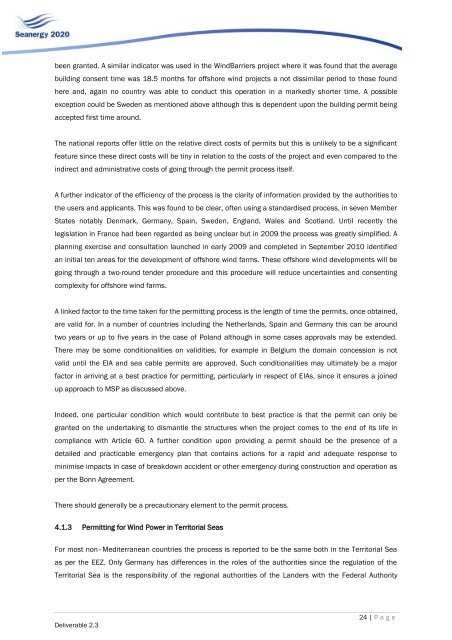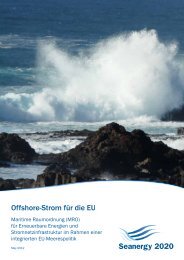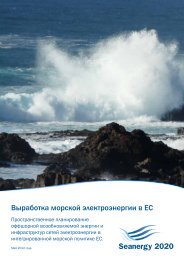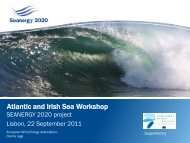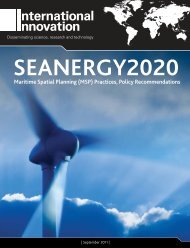Comparative analysis of Maritime Spatial Planning ... - Seanergy 2020
Comparative analysis of Maritime Spatial Planning ... - Seanergy 2020
Comparative analysis of Maritime Spatial Planning ... - Seanergy 2020
You also want an ePaper? Increase the reach of your titles
YUMPU automatically turns print PDFs into web optimized ePapers that Google loves.
een granted. A similar indicator was used in the WindBarriers project where it was found that the averagebuilding consent time was 18.5 months for <strong>of</strong>fshore wind projects a not dissimilar period to those foundhere and, again no country was able to conduct this operation in a markedly shorter time. A possibleexception could be Sweden as mentioned above although this is dependent upon the building permit beingaccepted first time around.The national reports <strong>of</strong>fer little on the relative direct costs <strong>of</strong> permits but this is unlikely to be a significantfeature since these direct costs will be tiny in relation to the costs <strong>of</strong> the project and even compared to theindirect and administrative costs <strong>of</strong> going through the permit process itself.A further indicator <strong>of</strong> the efficiency <strong>of</strong> the process is the clarity <strong>of</strong> information provided by the authorities tothe users and applicants. This was found to be clear, <strong>of</strong>ten using a standardised process, in seven MemberStates notably Denmark, Germany, Spain, Sweden, England, Wales and Scotland. Until recently thelegislation in France had been regarded as being unclear but in 2009 the process was greatly simplified. Aplanning exercise and consultation launched in early 2009 and completed in September 2010 identifiedan initial ten areas for the development <strong>of</strong> <strong>of</strong>fshore wind farms. These <strong>of</strong>fshore wind developments will begoing through a two-round tender procedure and this procedure will reduce uncertainties and consentingcomplexity for <strong>of</strong>fshore wind farms.A linked factor to the time taken for the permitting process is the length <strong>of</strong> time the permits, once obtained,are valid for. In a number <strong>of</strong> countries including the Netherlands, Spain and Germany this can be aroundtwo years or up to five years in the case <strong>of</strong> Poland although in some cases approvals may be extended.There may be some conditionalities on validities, for example in Belgium the domain concession is notvalid until the EIA and sea cable permits are approved. Such conditionalities may ultimately be a majorfactor in arriving at a best practice for permitting, particularly in respect <strong>of</strong> EIAs, since it ensures a joinedup approach to MSP as discussed above.Indeed, one particular condition which would contribute to best practice is that the permit can only begranted on the undertaking to dismantle the structures when the project comes to the end <strong>of</strong> its life incompliance with Article 60. A further condition upon providing a permit should be the presence <strong>of</strong> adetailed and practicable emergency plan that contains actions for a rapid and adequate response tominimise impacts in case <strong>of</strong> breakdown accident or other emergency during construction and operation asper the Bonn Agreement.There should generally be a precautionary element to the permit process.4.1.3 Permitting for Wind Power in Territorial SeasFor most non–Mediterranean countries the process is reported to be the same both in the Territorial Seaas per the EEZ. Only Germany has differences in the roles <strong>of</strong> the authorities since the regulation <strong>of</strong> theTerritorial Sea is the responsibility <strong>of</strong> the regional authorities <strong>of</strong> the Landers with the Federal AuthorityDeliverable 2.324 | P a g e


